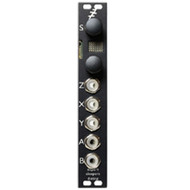Expert Sleepers - Disting MK 4
by Tim Held
How does one review something like the Disting MK 4 from Expert Sleepers? It is almost akin to describing a cloud in the wind or a time-lapse video of a high rise being built. The Disting isn’t a “thing”, despite its name convincing you otherwise, and is in a constant state of evolution. However, this difficulty in describing it is due to what may be the most fascinating thing about this module: it is a union of outstanding physical design and robust firmware that might be the real-world analog to Skynet.
What began as a 16-in-1 multi-functional module is now on its fourth version with a whopping 97 distinct algorithms that range from utilities to effects to sound sources and beyond. One of the biggest improvements made by Expert Sleepers with the MK 4 over previous incarnations is the LED screen. What was already a reasonably navigable module is now supremely accessible. Like many public swimming pools, this menu has a no diving policy, something very much appreciated by me.
What initially drew me to the Disting was its delay capabilities. Currently the Disting has four different delay algorithms: Tape Delay, Voltage Controlled Delay Line, Ping Pong Delay [Z feedback], and Clockable Ping Pong Delay [Z input scan]. I highly recommend all of them, though the Ping Pong [Z feedback] is the one I gravitate towards the most. This algorithm is a simple yet highly effective stereo delay; one audio input, two audio outputs, with clock input and feedback input. Of course the clock and feedback are manually adjustable via the two encoders. The CV control of the time and feedback track very smoothly and you can get some very engaging results when the right audio and CV signals are used. The Ping Pong delay shines brightest in its stereo capabilities, and I love putting soft percussive patterns through it to create a sense of space within a patch. Before you go spending four-hundo on a dedicated delay, ask yourself what you want out of the effect. You may find the Disting MK 4 has everything you need.
When I got my first functioning modular setup way back when, one of the first things I tried was the classic bassline that ducked with every kick drum hit. Of course, this is achievable with the use of envelopes and VCAs, but why use up those patch points when you can have the Disting do it with only 3 patch cables? Typically the audio signal itself is what drives gain reduction when concerning compression, but within this algorithm, gain reduction is controlled by an external signal–audio or CV–making for a super easy patch.
I’m not sure VCO is the first thing that comes to mind when modular enthusiasts hear the word Disting, but I am going to work on changing that. I initially thought the VCO algorithms would be most useful to cover my more basic oscillator needs, but I was pleasantly surprised to find that within the different combinations of waveforms and the way you could shape them with CV, that the waveshaping VCO is a contender in the fight for the main voice in a patch. Between the 2 outputs, this algorithm offers parameters that allow for 3 different combinations of waveforms: triangle/square and triangle/square, triangle/square and sub-octave square, and square/pulse and sub-octave square. Additionally, each output’s waveshape/PWM can be attenuated manually or by CV control. I recommend starting with a simple sequence fed into the 1V/octave and a slow LFO into the waveshape/PWM input and slowly increasing the LFO speed to audio rate to get a feel for this algorithm’s character.
In terms of available samplers, there seems to be a lot of variation in functionality, and Disting’s sampler algorithms may be its crown jewel. One feature that very few samplers have is the ability to play two samples at one time, something the Disting’s dual audio playback algorithm supplies, with each sample having its own input and output. This is excellent for triggering drum samples, and in fact this algorithm was designed with that intention in mind, though it certainly isn’t limited to that. Having the ability to use multiple sets of samples–and two at a time–is extraordinarily useful to have in your setup, whether it be for percussive elements, call and response vocal samples, or even extended, lush pads to bleep and blop over.
I have found this to be a super helpful and versatile module. Unlike many multi-function gadgets in the music gear world, the Disting MK 4 does a lot, and does it all well. You could literally build a complete system out of only Distings. It’s affordable, easy to update, has an amazing manual, a mountain of demo videos, and is only 4HP. I say this with no hyperbole: I want at least 4 Distings in my setup.
4 HP 51mA +12V 19mA -12V
Price: $189


